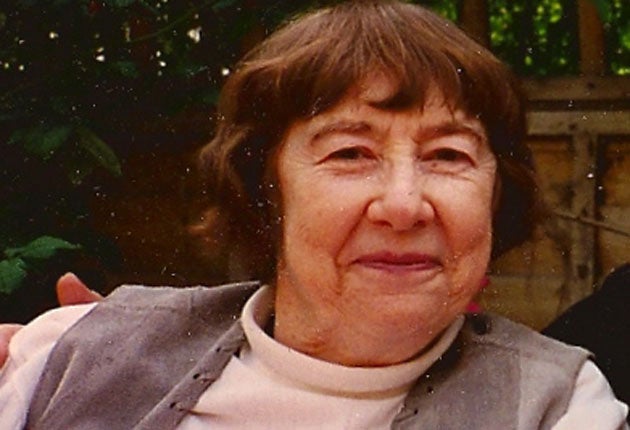M-J Lancaster: Outspoken writer and editor who became a prototype of the modern career woman

It was not surprising that Miss Hope-Nicholson shortened her first name to M-J, christened as she was, Marie-Jaqueline, Dorothea, Beatrice, Alexina, Romaine, Adriana. Her decision reflected the future editor's outspoken, forthright manner, possibly a reaction against her deeply eccentric family. Her father, Hedley Hope-Nicholson, was heir to a raincoat fortune and head of the Carolean Society; he was obsessed with Charles I and kept a relic from the King's coffin – and a piece of the shirt he wore on the scaffold – in a box in the consecrated chapel in their London family at More House in Tite Street.
M-J's grandmother was Laura Troubridge, married to Adrian Hope, one of the founders of the Great Ormond Street Children's Hospital, and together they were the guardians to Cyril and Vivian Holland, Oscar Wilde's children. Her aunt was Una Troubridge, who ran off with the famous lesbian Radclyffe Hall. And her mother, Jaqueline, was obsessed with doll's houses – which also lived in the More House chapel along with the relics – to such an extent that she even wrote the diaries of the inhabitants.
M-J's brother, Felix, spent his entire life in the house where they were all born and, initially, educated. He continued the tradition his mother had started of having paying guests to finance the running of the huge house. An endless stream of fascinating people – from Lord Lambton and Julian Maclaren Ross to Lucien Freud – all lodged there at one time or another.
M-J's first job was in the war office at Wormwood Scrubs, progressing to Blenheim, Birmingham and Wands-worth. She was obviously extremely efficient because when she returned to work in Birmingham after 12 days' sick leave, her boss announced: "The war can proceed now Miss Hope-Nicholson is back."
The notorious spy, Anthony Blunt worked in the same office and she always wondered why he worked so late and was so punctilious in locking up his filing cabinets at night. After work she would take a train from Birmingham to London and spend evenings at the Ritz bar, going on afterwards to one of her favourite Soho haunts, like the Conga, the Stafford, the Suisse, the French Club, the Boeuf, the Music Box, the Panama, the Cuba, the Nuthouse, the Cafe Royal, the Jamboree or the racy Gargoyle Club – where, with Lucien Freud, she was once turned away because he was wearing his sailor's uniform. Among her friends then were Norman Douglas, Augustus John, Michael Arlen, Harold Acton, John Banting, Stephen Tennant and Cyril Connolly, and, of course, Dylan Thomas, who once licked the pencilled lines she'd drawn on the backs of her legs to give the impression that she was wearing stockings. However, she didn't have to resort to these tricks for long because she was brought a pair of silk stockings from Washington by another spy, Guy Burgess.
In 1945 she married Maurice Lancaster, who was 17 years her senior, then a war correspondent working for Britain and the US who was also involved in making films for The March of Time all over the world. Later he became general manager of Harpers Bazaar while M-J worked as press officer for the Council of Industrial Design. He cut an elegant figure with immaculately cut clothes, a velvet-collared overcoat and a silver-topped cane, rather reminiscent, according to a friend, of Diaghilev.
Although she always wanted to work in films, she never got the chance, and when ill-health forced Maurice's retirement she became the main breadwinner, becoming one of the earliest career women, not an easy feat in those pre-feminist times. Determined and ambitious, she edited House Beautiful, then Trio, the first in-house magazine of Sainsbury's, and eventually edited a series of part-works for BPC such as the Cordon Bleu Cookery Course and a gardening course called Green Fingers, a publication she particularly loathed, being more interested in their series on the British Empire. She was straight-talking and considered formidable by those she worked with, being famously intolerant of weak writing and missed deadlines; she was especially fastidious when it came to the index.
Her and Maurice's parties were notorious, her houses and flats always impeccably decorated and very avant-garde. Even in the Fifties she would decorate rooms in black and gold, with Roman and Greek motifs and Fornasetti plates on the walls.
Later in her life she edited a series of charming letters written by her ancestors, Life Amongst the Troubridges: Journals of a Young Victorian, 1873-84, and Letters of Engagement 1884-1888: The Love Letters of Adrian Hope and Laura Troubridge. She also wrote a definitive biography of her friend, the poet and Brideshead aesthete Brian Howard, called Brian Howard: Portrait of a Failure.
Marie-Jaqueline Hope-Nicholson, writer and editor: born London 9 August 1922; married 1945 Maurice Lancaster (two daughters); died 17 May 2010.
Subscribe to Independent Premium to bookmark this article
Want to bookmark your favourite articles and stories to read or reference later? Start your Independent Premium subscription today.

Join our commenting forum
Join thought-provoking conversations, follow other Independent readers and see their replies